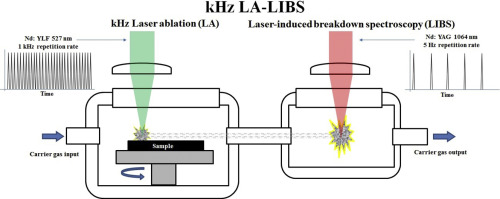当前位置:
X-MOL 学术
›
Spectrochim. Acta B. At. Spectrosc.
›
论文详情
Our official English website, www.x-mol.net, welcomes your feedback! (Note: you will need to create a separate account there.)
Laser ablation at high repetition rate coupled to laser-induced breakdown spectroscopy for analysis of non-matrix matched standards
Spectrochimica Acta Part B: Atomic Spectroscopy ( IF 3.3 ) Pub Date : 2020-04-01 , DOI: 10.1016/j.sab.2020.105795 Daniel Diaz , David W. Hahn
Spectrochimica Acta Part B: Atomic Spectroscopy ( IF 3.3 ) Pub Date : 2020-04-01 , DOI: 10.1016/j.sab.2020.105795 Daniel Diaz , David W. Hahn

|
Abstract Laser ablation at kilohertz repetition rate coupled to laser-induced breakdown spectroscopy (kHz LA-LIBS) was used for the analysis of non-matrix matched metallic standards. Kilohertz LA-LIBS exploited the demonstrated advantages of the analytical technique referred to as laser-ablation laser-induced breakdown spectroscopy (LA-LIBS), while at the same time increased the amount of ablated mass available for analysis. By separating the laser ablation process from the excitation and analysis stages, every configuration of LA-LIBS has demonstrated to produce better analytical results during the analysis of non-matrix matched samples. This research reports the analytical response of five analytes (Al, Cu, Fe, Mg and Mn) from eight standard reference materials. The standards included four aluminum alloys, a high temperature alloy, a cupro‑nickel alloy, a stainless steel and a low alloy steel. The analytical performance of kHz LA-LIBS was evaluated through the estimation of the signal-to-noise ratio, relative standard deviation, linearity and y-intercept of calibration curves and limits of detection. Calibration plots relating the analyte concentration to the Fe-normalized (internal standard), peak-to-background and net intensities were constructed. The increased amount of ablated mass in kHz-LA-LIBS rendered superior figures compared with traditional LIBS and other LA-LIBS configurations. The limits of detection of kHz LA-LIBS were improved by 3 to 14 times as compared to those reported previously and were estimated in the range of 0.07 and 0.30% by mass.
中文翻译:

高重复率激光烧蚀与激光诱导击穿光谱相结合,用于非基质匹配标准的分析
摘要 与激光诱导击穿光谱 (kHz LA-LIBS) 耦合的千赫重复率激光烧蚀用于非基质匹配金属标准的分析。Kilohertz LA-LIBS 利用了被称为激光烧蚀激光诱导击穿光谱 (LA-LIBS) 的分析技术的显着优势,同时增加了可用于分析的烧蚀质量。通过将激光烧蚀过程与激发和分析阶段分开,LA-LIBS 的每种配置都已证明在非基质匹配样品的分析过程中产生更好的分析结果。本研究报告了来自八种标准参考物质的五种分析物(Al、Cu、Fe、Mg 和 Mn)的分析响应。标准包括四种铝合金、一种高温合金、铜镍合金、不锈钢和低合金钢。kHz LA-LIBS 的分析性能是通过估计信噪比、相对标准偏差、线性度和校准曲线的 y 截距和检测限来评估的。构建了将分析物浓度与 Fe 归一化(内标)、峰-背景和净强度相关联的校准图。与传统 LIBS 和其他 LA-LIBS 配置相比,kHz-LA-LIBS 中烧蚀质量的增加呈现出优异的数字。与之前报道的相比,kHz LA-LIBS 的检测限提高了 3 到 14 倍,估计在 0.07 到 0.30% 的质量范围内。kHz LA-LIBS 的分析性能是通过估计信噪比、相对标准偏差、线性度和校准曲线的 y 截距和检测限来评估的。构建了将分析物浓度与 Fe 归一化(内标)、峰-背景和净强度相关联的校准图。与传统 LIBS 和其他 LA-LIBS 配置相比,kHz-LA-LIBS 中烧蚀质量的增加呈现出优异的数字。与之前报道的相比,kHz LA-LIBS 的检测限提高了 3 到 14 倍,估计在 0.07 到 0.30% 的质量范围内。kHz LA-LIBS 的分析性能是通过估计信噪比、相对标准偏差、线性度和校准曲线的 y 截距和检测限来评估的。构建了将分析物浓度与 Fe 归一化(内标)、峰-背景和净强度相关联的校准图。与传统 LIBS 和其他 LA-LIBS 配置相比,kHz-LA-LIBS 中烧蚀质量的增加呈现出优异的数字。与之前报道的相比,kHz LA-LIBS 的检测限提高了 3 到 14 倍,估计在 0.07 到 0.30% 的质量范围内。构建了将分析物浓度与 Fe 归一化(内标)、峰-背景和净强度相关联的校准图。与传统 LIBS 和其他 LA-LIBS 配置相比,kHz-LA-LIBS 中烧蚀质量的增加提供了更好的数字。与之前报道的相比,kHz LA-LIBS 的检测限提高了 3 到 14 倍,估计在 0.07 到 0.30% 的质量范围内。构建了将分析物浓度与 Fe 归一化(内标)、峰-背景和净强度相关联的校准图。与传统 LIBS 和其他 LA-LIBS 配置相比,kHz-LA-LIBS 中烧蚀质量的增加呈现出优异的数字。与之前报道的相比,kHz LA-LIBS 的检测限提高了 3 到 14 倍,估计在 0.07 到 0.30% 的质量范围内。
更新日期:2020-04-01
中文翻译:

高重复率激光烧蚀与激光诱导击穿光谱相结合,用于非基质匹配标准的分析
摘要 与激光诱导击穿光谱 (kHz LA-LIBS) 耦合的千赫重复率激光烧蚀用于非基质匹配金属标准的分析。Kilohertz LA-LIBS 利用了被称为激光烧蚀激光诱导击穿光谱 (LA-LIBS) 的分析技术的显着优势,同时增加了可用于分析的烧蚀质量。通过将激光烧蚀过程与激发和分析阶段分开,LA-LIBS 的每种配置都已证明在非基质匹配样品的分析过程中产生更好的分析结果。本研究报告了来自八种标准参考物质的五种分析物(Al、Cu、Fe、Mg 和 Mn)的分析响应。标准包括四种铝合金、一种高温合金、铜镍合金、不锈钢和低合金钢。kHz LA-LIBS 的分析性能是通过估计信噪比、相对标准偏差、线性度和校准曲线的 y 截距和检测限来评估的。构建了将分析物浓度与 Fe 归一化(内标)、峰-背景和净强度相关联的校准图。与传统 LIBS 和其他 LA-LIBS 配置相比,kHz-LA-LIBS 中烧蚀质量的增加呈现出优异的数字。与之前报道的相比,kHz LA-LIBS 的检测限提高了 3 到 14 倍,估计在 0.07 到 0.30% 的质量范围内。kHz LA-LIBS 的分析性能是通过估计信噪比、相对标准偏差、线性度和校准曲线的 y 截距和检测限来评估的。构建了将分析物浓度与 Fe 归一化(内标)、峰-背景和净强度相关联的校准图。与传统 LIBS 和其他 LA-LIBS 配置相比,kHz-LA-LIBS 中烧蚀质量的增加呈现出优异的数字。与之前报道的相比,kHz LA-LIBS 的检测限提高了 3 到 14 倍,估计在 0.07 到 0.30% 的质量范围内。kHz LA-LIBS 的分析性能是通过估计信噪比、相对标准偏差、线性度和校准曲线的 y 截距和检测限来评估的。构建了将分析物浓度与 Fe 归一化(内标)、峰-背景和净强度相关联的校准图。与传统 LIBS 和其他 LA-LIBS 配置相比,kHz-LA-LIBS 中烧蚀质量的增加呈现出优异的数字。与之前报道的相比,kHz LA-LIBS 的检测限提高了 3 到 14 倍,估计在 0.07 到 0.30% 的质量范围内。构建了将分析物浓度与 Fe 归一化(内标)、峰-背景和净强度相关联的校准图。与传统 LIBS 和其他 LA-LIBS 配置相比,kHz-LA-LIBS 中烧蚀质量的增加提供了更好的数字。与之前报道的相比,kHz LA-LIBS 的检测限提高了 3 到 14 倍,估计在 0.07 到 0.30% 的质量范围内。构建了将分析物浓度与 Fe 归一化(内标)、峰-背景和净强度相关联的校准图。与传统 LIBS 和其他 LA-LIBS 配置相比,kHz-LA-LIBS 中烧蚀质量的增加呈现出优异的数字。与之前报道的相比,kHz LA-LIBS 的检测限提高了 3 到 14 倍,估计在 0.07 到 0.30% 的质量范围内。



























 京公网安备 11010802027423号
京公网安备 11010802027423号